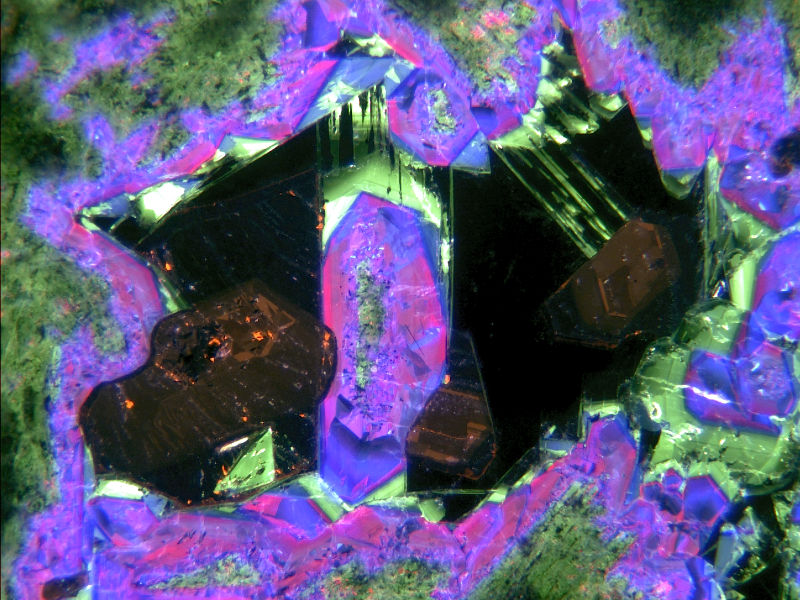IEC - General Information
History
Impressed by the beauty of the metamorphic rock from Saualpe, Austria, René-Just Haüy (1743–1822) created the name “eclogite” (the chosen rock), which he derived from the Greek word εκλογή (choice). The name eclogite was used for the first time in 1822 in the second edition of Haüy's famous book “Traité de mineralogie”. The first “scientific” description, however, dates back to the second half of the 18th century, when Horace-Bénédict de Saussure (1740–1799) indicated a “beautiful rock that is not described yet” from the Rhone valley in his “Voyages dans les Alpes”. In the 20th century eclogite became accepted as a high-pressure metamorphic rock and in the mid nineteen eighties metamorphic coesite (later also diamond) was discovered in eclogite facies rocks. This generated numerous new research projects with enormous implications for petrology, geodynamics, global tectonics, seismology, and geochemical recycling.
A dramatic increase of studies in the field of high-pressure metamorphism, including those on natural samples, high-pressure experiments, and computer modelling, led in 1982 to organization of the first International Eclogite Conference (IEC), established by David Smith. This first meeting was very successful, and since then the IEC has represented an important event of international reputation. In the past, the IEC was held every 4 years, and irregularly in between, "International Eclogite Field Symposia” were organized. At the beginning of the 21st century, it turned out that the tenor of both the IEC´s and the International Eclogite Field Symposia converged more and more. Consequently, during the business meeting of the International Eclogite Conference Co-ordinating Committee (IECCC) in Seggau, Graz (Austria) in 2007, it was decided that, beginning with IEC-8 in Xining (China), the meetings should take place every two years as IEC´s (thus the former Eclogite Field Symposia were replaced by IEC´s). The last Eclogite Field Symposium took place between June 29th and July 6th in Glasgow, Scotland, and was organized by Simon Cuthbert and Craig Storey.
To sum up, “Whatever the reasons, eclogite studies over two centuries have produced numerous questions, hypotheses, theories and controversies, which all together have been exceptionally fruitful. They represent a nice example of the relevance and efficiency of the inductive method in science, which is based on the accurate observation of facts.” Gaston Godard (2001)
Past Interntational Eclogite Conferences
1982 IEC-I Clermont-Ferrand, France
1985 IEC-II Vienna, Austria
1989 IEC-III Würzburg, Germany
1993 IEC-IV Cosenza, Italy
1997 IEC-V Ascona, Switzerland
2001 IEC-VI Niimaha, Shikoku, Japan
2005 IEC-VII Seggau, Austria
2009 IEC-VIII Xining,China
2013 IEC-X Courmayeur, Italy
International Eclogite Field Symposia (IEFS)
1987 IEFS-I Bergen to Molde, Western Norway
1991 IEFS-II Granada, Malaga, La Coruña, Spain
1995 IEFS-III Hefei, China
1999 IEFS-IV Russia-Kazakhstan
2003 IEFS-V “Alice Wain Memorial West Norway”, Selje, Norway
2007 IEFS-VI Portree, Scotland
By-laws
- The International Eclogite Conference (IEC) takes place every two years as an international scientific meeting focussing on high and ultrahigh pressure rocks and minerals.
- During the IEC´s, an official business meeting of the International Eclogite Conference Coordination Committee (IECCC) shall be convened. The IECCC shall consist of one delegate from each country, from which regularly attending participants play an active role in the success of the IEC. Currently (July 2014), the committee is composed of delegates from 21 countries.
- The official business meetings shall be attended only by the present delegates of the IECCC. If a delegate from a particular country is absent, a substitute for that meeting can be proposed by that delegate. In order to achieve effective and successful future planning, after the confidential part of the business meeting, the official IECCC delegate and additional members of the local organization committee of the host country for the upcoming meeting shall be invited. After the meeting, the non-confidential results are presented by the president and the committee to interested IEC attendees.
- Only the IECCC has the right to nominate a new delegate and to change the number of delegates. The appointment of a new committee delegate or the change of delegates will be discussed and decided in the business-meeting by the present IECCC delegates solely.
- Only the IECCC decides about place and date of future IEC´s based on presentation of proposals and discussion in a business meeting.
- Customarily, at the closing ceremony of an IEC, the former president will hand over the chair to the new president, who shall be the managing organizer of the current IEC, for the following 2 years.
Previous presidents of the IEC
David C. Smith (Paris, France)
Heinz G. Scharbert (Vienna, Austria)
Martin Okrusch (Würzburg, Germany)
Lauro Morten (Cosenza, Italy)
Volkmar Trommsdorff (Zürich, Switzerland)
Takao Hirajima (Kyoto, Japan)
Georg Hoinkes (Graz, Austria)
Kai Ye (Beijing, China)
Daniele Castelli (Torino, Italy) – current president
(as of July 2014)
1. Cho, Moonsup, South Korea
2. Castelli, Daniele, Italy
3. Cuthbert, Simon, United Kingdom
4. De Hoog Cees, Jan, Denmark
5. Faryad, Shah Wali, Czech Republic
6. Ghent, Edward, Canada
7. Gilotti, Jane, USA
8. Hirajima, Takao, Japan
9. Hoinkes, Georg, Austria
10. Jahn, Bor-Ming, Taiwan
11. Janák, Marian, Slovak Republic
12. Liati, Anthi, Switzerland
13. Möller, Charlotte, Sweden
14. Perraki, Maria, Greece
15. Rubatto, Daniela, Canberra, Australia
16. Schertl, Hans-Peter, Germany
17. Shatsky, Vladislav, Russia
18. Smith, David, France
19. Van Roermund, Herman, The Netherlands
20. Vrabec, Mirijam, Slovenia
21. Zheng, Yong-Fei, China

